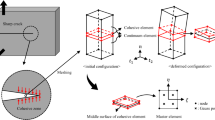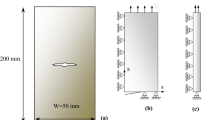Abstract
Cohesive zone modeling of fatigue crack growth retardation in aerospace titanium alloy Ti–6Al–4V subjected to a single overload during constant amplitude is presented in this work. The cyclic softening behavior of the bulk material is simulated according to the Ohno–Wang’s cyclic plasticity theory. The fracture process zone is represented by an irreversible cohesive law which governs the material separation of fatigue crack. The material degradation mechanism is described by the gradual reduction of the unloading cohesive stiffness after each loading cycle. The fatigue crack growth behaviors are examined using the proposed cohesive model under both constant and variable amplitude loadings. The computational results are verified according to the experimental data, which confirm that the present model can be applied to predict the transient retardation in fatigue crack growth rate of the Ti–6Al–4V alloy accurately.















Similar content being viewed by others
References
Paris, P.C., Gomez, M.P., Anderson, W.P.: A rational analytic theory of fatigue. Trend Eng. 13, 9–14 (1961)
Kondo, Y.: Fatigue under variable amplitude loading. In: Milne, I., Ritchie, R.O., Karihaloo, B. (eds.) Comprehensive Structural Integrity, pp. 263–279. Pergamon, Oxford (2003)
Newman, J.C.: Modeling of fatigue crack growth: numerical models. In: Milne, I., Ritchie, R.O., Karihaloo, B. (eds.) Comprehensive Structural Integrity, pp. 209–220. Pergamon, Oxford (2003)
Dugdale, D.S.: Yielding of steel sheets containing slits. J. Mech. Phys. Solids 8, 100–104 (1960)
Tvergaard, V., Hutchinson, J.W.: The relation between crack growth resistance and fracture process parameters in elastic–plastic solids. J. Mech. Phys. Solids 40, 1377–1397 (1992)
Yuan, H., Lin, G., Cornec, A.: Verification of a cohesive zone model for ductile fracture. J. Eng. Mater. Technol. 118, 192–200 (1996)
Roy, Y.A., Dodds Jr., R.H.: Simulation of ductile crack growth in thin aluminum panels using 3-D surface cohesive elements. Int. J. Fract. 110, 21–45 (2001)
Scheider, I., Brocks, W.: Simulation of cup-cone fracture using the cohesive model. Eng. Fract. Mech. 70, 1943–1961 (2003)
Wang, G., Li, S.F.: A penny-shaped cohesive crack model for material damage. Theor. Appl. Fract. Mech. 42, 303–316 (2004)
Xu, Y., Yuan, H.: Applications of normal stress dominated cohesive zone models for mixed-mode crack simulation based on extended finite element methods. Eng. Fract. Mech. 78, 544–558 (2011)
Rashid, F.Md, Banerjee, A.: Implementation and validation of a triaxiality dependent cohesive model: experiments and simulations. Int. J. Fract. 181, 227–239 (2013)
Schwalbe, K.-H., Scheider, I., Cornec, A.: Guidelines for Applying Cohesive Models to the Damage Behaviour of Engineering Materials and Structures. Springer, Berlin (2012)
Park, K., Paulino, G.H.: Cohesive zone models: a critical review of traction–separation relationships across fracture surfaces. Appl. Mech. Rev. 64, 060802 (2013)
Kuna, M., Roth, S.: General remarks on cyclic cohesive zone models. Int. J. Fract. 196, 147–167 (2015)
de Andres, A., Perez, J.L., Ortiz, M.: Elastoplastic finite element analysis of three-dimensional fatigue crack growth in aluminum shafts subjected to axial loading. Int. J. Solids Struct. 36, 2231–2258 (1999)
Serebrinsky, S., Ortiz, M.: A hysteretic cohesive-law model of fatigue-crack nucleation. Scr. Mater. 53, 1193–1196 (2005)
Roth, S., Hütter, G., Kuna, M.: Simulation of fatigue crack growth with a cyclic cohesive zone model. Int. J. Fract. 188, 23–45 (2014)
Ural, A., Krishnan, V.R., Papoulia, K.D.: A cohesive zone model for fatigue crack growth allowing for crack retardation. Int. J. Solids Struct. 46, 2453–2462 (2009)
Beaurepaire, P., Schuëller, G.I.: Modeling of the variability of fatigue crack growth using cohesive zone elements. Eng. Fract. Mech. 78, 2399–2413 (2011)
Nguyen, O., Repetto, E.A., Ortiz, M., Radovitzky, R.A.: A cohesive model of fatigue crack growth. Int. J. Fract. 110, 351–369 (2001)
Eliaš, J., Le, J.-L.: Modeling of mode-I fatigue crack growth in quasi-brittle structures under cyclic compression. Eng. Fract. Mech. 96, 26–36 (2012)
Roe, K.L., Siegmund, T.: An irreversible cohesive zone model for interface fatigue crack growth simulation. Eng. Fract. Mech. 70, 209–232 (2003)
Maiti, S., Geubelle, P.H.: Cohesive modeling of fatigue crack retardation in polymers: crack closure effect. Eng. Fract. Mech. 73, 22–41 (2006)
Jiang, H., Gao, X., Srivatsan, T.S.: Predicting the influence of overload and loading mode on fatigue crackgrowth: A numerical approach using irreversible cohesive elements. Finite Elem. Anal. Des. 45, 675–685 (2009)
Zhang, M., Zhang, J., McDowell, D.L.: Microstructure-based crystal plasticity modeling of cyclic deformation of Ti–6Al–4V. Int. J. Plast. 23, 1328–1348 (2007)
Ohno, N., Wang, J.: On modelling of kinematic hardening for ratcheting behaviour. Nucl. Eng. Des. 153, 205–212 (1995)
Dunne, F., Petrinic, N.: Introduction to Computational Plasticity. Oxford University Press, Oxford (2005)
Kang, G., Dong, Y., Liu, Y., Jiang, H.: Macroscopic and microscopic investigations on uniaxial ratchetting of two-phase Ti–6Al–4V alloy. Mater. Charact. 92, 26–35 (2014)
Paggi, M., Wriggers, P.: A nonlocal cohesive zone model for finite thickness interfaces-Part I: mathematical formulation and validation with molecular dynamics. Comput. Mater. Sci. 50, 1625–1633 (2011)
Krull, H., Yuan, H.: Suggestions to the cohesive traction–separation law from atomistic simulations. Eng. Fract. Mech. 78, 525–533 (2011)
Brocks, W.: Cohesive strength and separation energy as characteristic parameters of fracture toughness and their relation to micromechanics. SID 1, 233–243 (2005)
Brocks, W., Scheider, I., Schödel, M.: Simulation of crack extension in shell structures and prediction of residual strength. Arch. Appl. Mech. 76, 655–665 (2006)
Hutchinson, J.W.: Closing in on the crack tip. In: Willis, J.R. (ed.) IUTAM Symposium on Nonlinear Analysis of Fracture, pp. 81–91. Kluwer Academic Publishers, Dordrecht (1997)
Allahverdizadeh, N., Gilioli, A., Manes, A., Giglio, M.: An experimental and numerical study for the damage characterization of a Ti–6Al–4V titanium alloy. Int. J. Mech. Sci. 93, 32–47 (2015)
Li, H., Yuan, H., Li, X.: Assessment of low cycle fatigue crack growth under mixed-mode loading conditions by using acohesive zone model. Int. J. Fatigue 75, 39–50 (2015)
Li, H., Chandra, N.: Analysis of crack growth and crack-tip plasticity in ductile materials using cohesive zone models. Int. J. Plast. 19, 849–882 (2003)
ABAQUS Version 6.11. User Subroutines Reference Manual. Dassault Systemes Simulia Corp., Providence (2011)
Korsunsky, A.M., et al.: Crack tip deformation fields and fatigue crack growth rates in Ti–6Al–4V. Int. J. Fatigue 31, 1771–1779 (2009)
ASTM E 647-00: Standard Test Method for Measurement of Fatigue Crack Growth Rates (2000)
Liu, J., Xiang, C., Yuan, H.: Prediction of 3D small fatigue crack propagation in shot-peend specimens. Comput. Mater. Sci. 46, 566–571 (2009)
Xu, Y., Yuan, H.: On the damage accumulation in the cyclic cohesive zone model for XFEM analysis of mixed-mode fatigue crack growth. Comput. Mater. Sci. 46, 579–585 (2009)
Li, H., Yuan, H.: Cohesive zone modeling of low cycle fatigue cracks in cracked and notched specimens. Fatigue Fract. Eng. Mater. Struct. 36, 1246–1257 (2013)
Acknowledgements
Financial support provided by the National Natural Science Foundation of China (No. 11502204) and research start-up fund of Northwestern Polytechnical University (No. G2015KY0303) are acknowledged.
Author information
Authors and Affiliations
Corresponding author
Rights and permissions
About this article
Cite this article
Li, H., Li, C. & Yuan, H. Prediction of fatigue crack growth retardation using a cyclic cohesive zone model. Arch Appl Mech 87, 1061–1075 (2017). https://doi.org/10.1007/s00419-017-1232-2
Received:
Accepted:
Published:
Issue Date:
DOI: https://doi.org/10.1007/s00419-017-1232-2




